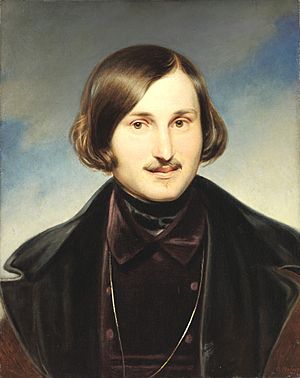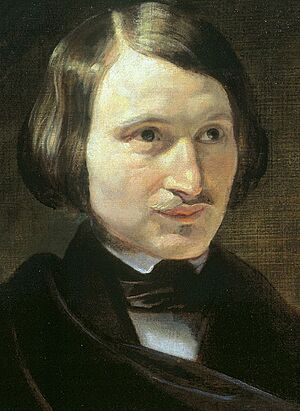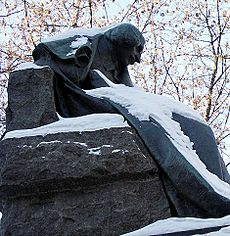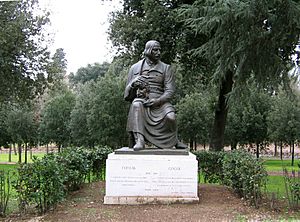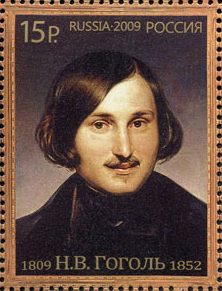Nikolai Gogol facts for kids
Quick facts for kids
Nikolai Gogol
|
|
|---|---|
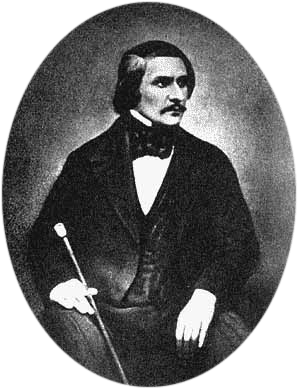
Daguerreotype of Gogol taken in 1845 by Sergei Lvovich Levitsky (1819–1898)
|
|
| Born | Nikolai Vasilyevich Yanovsky 20 March 1809 (OS)/1 April 1809 (NS) Sorochyntsi, Poltava Governorate, Russian Empire |
| Died | 21 February 1852 (aged 42) Moscow, Moscow Governorate, Russian Empire |
| Resting place | Novodevichy Cemetery |
| Occupation | Playwright, short story writer, novelist |
| Language | Russian |
| Period | 1840–51 |
| Notable works |
Petersburg Tales (1833–1842)
|
| Signature | |
 |
|
Nikolai Vasilyevich Gogol (born April 1, 1809 – died March 4, 1852) was a famous Russian writer. He wrote novels, short stories, and plays. Gogol was born in a town called Sorochyntsi, which was part of the Russian Empire at the time. His family had Ukrainian roots.
Gogol was one of the first writers to use a special style called the grotesque. This means he mixed strange, funny, and sometimes scary things in his stories. Some of his well-known works that use this style include "The Nose" and "The Overcoat". His early stories, like those in Evenings on a Farm Near Dikanka, were inspired by his Ukrainian background and folklore. Later, he wrote stories that made fun of problems in the government, like The Government Inspector and Dead Souls. Many famous writers, like Fyodor Dostoevsky and Franz Kafka, were influenced by Gogol's unique way of writing.
Contents
Early Life and School Days
Nikolai Gogol was born in a Ukrainian Cossack town called Sorochyntsi. His father, Vasily Gogol-Yanovsky, was a writer himself and loved theater. He wrote poetry and plays in both Ukrainian and Russian. Gogol's father passed away when Nikolai was only 15 years old.
As a child, Gogol enjoyed helping with plays at his uncle's home theater. In 1820, he went to a school in Nezhin. He stayed there until 1828 and started writing during this time. He wasn't very popular with his classmates, but he made a few good friends. Gogol was a bit shy and kept to himself, but he had big dreams for his future. He was also good at mimicking people, which later helped him read his own stories in a fun way.
After school in 1828, Gogol moved to Saint Petersburg. He hoped to become a famous writer. He even published a poem called Hans Küchelgarten using a fake name. However, the poem was not liked by critics. Gogol was so disappointed that he bought all the copies and destroyed them. He promised himself he would never write poetry again.
Becoming a Famous Writer
In 1831, Gogol published his first collection of Ukrainian stories, Evenings on a Farm Near Dikanka. It was an instant hit! A second book followed in 1832. Then came two more collections, Mirgorod (1835) and Arabesques. At first, some critics thought of him as mainly a Ukrainian writer. His early stories were similar to those of his Ukrainian friends. But Gogol's writing was special because it was much more clever and unusual.
Gogol became very interested in Ukrainian Cossack history. He even tried to get a job teaching history at a university in Kyiv. Even with support from famous people like Alexander Pushkin, he didn't get the job. His story Taras Bulba, which is about the Zaporozhian Cossacks, came from his interest in history.
In 1834, Gogol became a professor of Medieval History at the University of St. Petersburg. But he wasn't really qualified for the job and quit in 1835.
Between 1832 and 1836, Gogol worked very hard and spent a lot of time with Pushkin. He wasn't sure if writing was his true calling yet. But everything changed after his play The Government Inspector was performed in 1836. This play made fun of corrupt government officials. Even the emperor, Nicholas I, liked it and helped it get staged. After this success, Gogol finally believed he was meant to be a writer.
From 1836 to 1848, Gogol lived in other countries, traveling through Germany, Switzerland, and France. He spent most of this time in Rome, Italy. He loved Rome and spent his time studying art, reading Italian books, and enjoying opera.
When his friend Pushkin died, Gogol was very sad. After this, he wrote his most important work, the satirical novel Dead Souls. He also rewrote Taras Bulba and finished his second play, Marriage. He also wrote his most famous short story, "The Overcoat".
In 1841, the first part of Dead Souls was ready. Gogol brought it to Russia to be printed. It came out in 1842 and made him one of the greatest writers of his time.
Later Life and Lasting Impact
After Dead Souls became popular, people saw Gogol as a writer who made fun of the problems in Russia. But Gogol had a bigger plan. He saw Dead Souls as just the first part of a story like Dante's Divine Comedy. The first part was like a journey through a difficult place. He planned for the second part to show how people could become better.
In 1848, Gogol returned to Russia after a trip to Jerusalem. He spent his last years moving around the country, staying with friends. He also spent time with his old Ukrainian friends. Gogol became very religious during this time. He believed that all his creative writing was sinful. This made him very sad and unhealthy.
On February 24, 1852, he sadly burned some of his writings, including most of the second part of Dead Souls. He later said it was a mistake. Soon after, he became very ill, stopped eating, and died nine days later.
Gogol was buried in Danilov Monastery in Moscow. Later, in 1931, his remains were moved to the Novodevichy Cemetery. When his grave was moved, a story started that he might have been buried alive, though this is just a legend. The original stone from his grave was later used for the tomb of another famous writer, Mikhail Bulgakov. In 2009, Gogol's original grave design was brought back.
Many streets and monuments are named after Gogol in different cities around the world. He has also been featured on postage stamps and coins. His stories and plays continue to be read and loved by people everywhere.
Gogol's Unique Writing Style
Gogol's writing style is very special and unique. One expert described his world as "one of the most marvelous, unexpected worlds ever created by an artist of words."
He had a way of seeing reality that was like an "impressionist" painting. He saw the world in a strange, changed way. This is clear in his spooky stories, where places seem to twist and change. His descriptions of nature are like piles of small details that don't always connect, creating a kind of beautiful chaos.
His characters are often like funny drawings, with their main features made bigger. But even these exaggerated characters feel very real and believable. Gogol's work helped start new types of stories, like spooky Gothic tales and stories that use absurd ideas.
A key idea in Gogol's writing is poshlost', a Russian word that means something like "triviality" or "banality." He often showed how everyday life could be empty or silly. Gogol was good at breaking rules and showing the funny side of things. His stories often mix sad feelings with humor. For example, "The Tale of How Ivan Ivanovich Quarreled with Ivan Nikiforovich" starts as a funny story but ends with a sad thought: "It is dull in this world, gentlemen!"
Gogol's Beliefs

Gogol was surprised when some people thought his play The Government Inspector was a criticism of the Russian government. He actually believed strongly in the Russian emperor and the Russian Orthodox Church. Like Fyodor Dostoevsky, Gogol disagreed with those who wanted to change Russia's government system. Gogol saw his writing as a way to help Russia become a better place.
In his book Selected Passages from Correspondence with his Friends (1847), Gogol defended the emperor and the Church. Because of this, some people who used to support him, like Vissarion Belinsky, criticized him. Belinsky thought Gogol was betraying his readers by supporting the way things were.
Gogol's Stories on Screen
Many of Gogol's stories have been turned into plays, movies, and even operas!
- BBC Radio 4 made a series of six Gogol short stories called Three Ivans, Two Aunts and an Overcoat (2002).
- His story "Christmas Eve" has been made into operas by three different composers: Mykola Lysenko, Pyotr Ilyich Tchaikovsky, and Nikolai Rimsky-Korsakov. It was also made into a film in 1961.
- Gogol's spooky story "Viy" has been adapted into films four times by Russian filmmakers, including the original Viy in 1967 and a more recent action-horror film in 2014. It even inspired films outside of Russia.
- In 2016, his short story "The Portrait" was announced to be made into a movie.
- A Russian TV series called Gogol features Nikolai Gogol as a main character. It mixes his real life with elements from his stories, creating a fictional adventure.
- An animated version of "The Nose" was made in 1963 using a special technique called pinscreen animation. A new animated movie based on "The Nose" was released in 2020.
See also
 In Spanish: Nikolái Gógol para niños
In Spanish: Nikolái Gógol para niños


